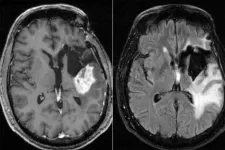OCD patients with comorbidities respond well to deep brain stimulation
A critical study examines how patients with psychiatric comorbidities respond to Deep Brain Stimulation treatment for Obsessive Compulsive Disorder
2021-03-31
(Press-News.org) AURORA, Colo. (March 31, 2021) - A new study published in Frontiers in Psychiatry finds that patients with Obsessive Compulsive Disorder (OCD) as well as other psychiatric comorbidities, such as autism spectrum or tic disorders, may respond well to Deep Brain Stimulation (DBS).
DBS is a minimally invasive neurosurgical procedure that uses coordinates to target certain areas of the brain, implanting electrodes that can help regulate abnormal brain activity. DBS procedures are rare for OCD in the United States; only a couple hundred patients have received this treatment for OCD management since its FDA approval in 2009 via a Humanitarian Device Exemption. The effectiveness of DBS for OCD has been well-documented in literature, but the interplay with comorbid disorders has not been as thoroughly explored.
"This study helps us understand more about real-world use of DBS for OCD," says Rachel Davis, MD, associate professor in the CU Department of Psychiatry and study principal investigator. "Most patients seeking treatment don't only have OCD, comorbidities are more the rule than the exception. So it's important to understand how this life-changing procedure can benefit our more typical patients."
Davis and clinicians at the University of Colorado Anschutz Medical Campus retrospectively examined five patients seeking DBS for OCD between 2015 and 2019. Patients exhibited comorbidities including substance use disorder, eating disorder, autism spectrum disorder, major depression, ADHD, and tic disorder. Three patients were awake during DBS surgery, allowing clinicians to check for response to stimulation (improved mood, increased energy, and reduction in anxiety), an additional way to confirm correct electrode placement. After surgery, Davis assessed response and determined the correct settings by asking patients about changes in mood, energy, and anxiety. Improvement in these areas tend to be associated with reduction in OCD symptoms later on. Change over time was monitored with a variety of IRB-approved questionnaires, gauging changes in mood, anxiety, depression and other quality of life elements affected by OCD.
Overall, these patients experienced significant improvement in OCD and mood symptoms. A standard scale for assessing symptom severity and treatment response in OCD, the Yale-Brown Obsessive-Compulsive Scale (YBOCS), measures degree of distress and impairment caused by obsessions and compulsions. A good clinical response is considered to be greater than a 35% reduction. In this study, patients averaged a 44% reduction on this scale; four out of five experienced full response with the fifth having a partial response, with approximately 25% reduction in OCD symptoms. Patients also reported an average of 53% reduction in depression symptoms.
"For these treatment-refractory OCD patients, our Psychiatric DBS program, led by Dr. Davis, is finally providing relief," says John Thompson, PhD, associate professor of neurosurgery at the University of Colorado School of Medicine and one of the co-authors on this manuscript. "While DBS for OCD is rare, this study is a glimpse at its potential. There is much yet to be learned about the complex interplay between circuit modulation and co-morbid symptom management in OCD patients treated with DBS."
INFORMATION:
About the University of Colorado Anschutz Medical Campus
The University of Colorado Anschutz Medical Campus is a world-class medical destination at the forefront of transformative science, medicine, education, and patient care. The campus encompasses the University of Colorado health professional schools, more than 60 centers and institutes, and two nationally ranked independent hospitals that treat more than two million adult and pediatric patients each year. Innovative, interconnected and highly collaborative, together we deliver life-changing treatments, patient care, professional training, and conduct world-renowned research. For more information, visit http://www.cuanschutz.edu.
ELSE PRESS RELEASES FROM THIS DATE:
2021-03-31
An aggressive type of brain cancer, glioblastoma has no cure. Patients survive an average of 15 months after diagnosis, with fewer than 10% of patients surviving longer than five years. While researchers are investigating potential new therapies via ongoing clinical trials, a new study from Washington University in St. Louis suggests that a minor adjustment to the current standard treatment -- giving chemotherapy in the morning rather than the evening -- could add a few months to patients' survival.
The study appears online in the journal Neuro-Oncology Advances.
Average overall survival ...
2021-03-31
AURORA, Colo. (March 30, 2021 - Researchers at the University of Colorado College of Nursing have found that nearly one-quarter of graduate nursing students have reported elevated levels of stress, anxiety and depression, compounded in the past year by the COVID-19 pandemic.
Study findings, published recently in END ...
2021-03-31
A new invention that uses sunlight to drive water purification could help solve the problem of providing clean water off the grid.
The device resembles a large sponge that soaks up water but leaves contaminants - like lead, oil and pathogens - behind. To collect the purified water from the sponge, one simply places it in sunlight. The researchers described the device in a paper published this week in the journal Advanced Materials.
The inspiration for the device came from the pufferfish, a species that takes in water to swell its body when threatened, and then releases water when danger passes, said the device's co-inventor END ...
2021-03-31
When it comes to powering mobile robots, batteries present a problematic paradox: the more energy they contain, the more they weigh, and thus the more energy the robot needs to move. Energy harvesters, like solar panels, might work for some applications, but they don't deliver power quickly or consistently enough for sustained travel.
James Pikul, assistant professor in Penn Engineering's Department of Mechanical Engineering and Applied Mechanics, is developing robot-powering technology that has the best of both worlds. His environmentally controlled voltage source, or ECVS, works like a battery, in that the energy is produced by repeatedly breaking ...
2021-03-31
In looking at the broader impact of the COVID-19 pandemic on health and wellbeing, public health experts are examining screening rates for cancer. A new study looking at U.S. mammography screening rates during the first five months of the pandemic found both a strong rebound in breast cancer screening rates and a concerning cumulative deficit in mammograms due to missed appointments, as well as uncovering disparities when looking at screening according to race.
The study was released this week in the Journal of the National Cancer Institute.
Conducted by investigators from the Breast Cancer Surveillance Coalition (BCSC), a federally-funded, national network of breast imaging registries, the study sought to quantify the impact of the COVID-19 ...
2021-03-31
Denver, CO, March 31, 2020 - Children with Down syndrome are 20-times more likely to develop acute lymphocytic leukemia (ALL) and 150-times more likely to develop acute myeloid leukemia (AML) compared to their typical peers. According to a new study by researchers at the Linda Crnic Institute for Down Syndrome, the reason could be that children with Down syndrome are more likely to present with clonal hematopoiesis (CH), a process in which a blood stem cell acquires a genetic mutation that promotes replication.
The findings, published online by Blood Advances, add to a growing body of evidence, much of which has been established ...
2021-03-31
Washington, DC-- Diamonds that formed deep in the Earth's mantle contain evidence of chemical reactions that occurred on the seafloor. Probing these gems can help geoscientists understand how material is exchanged between the planet's surface and its depths.
New work published in Science Advances confirms that serpentinite--a rock that forms from peridotite, the main rock type in Earth's mantle, when water penetrates cracks in the ocean floor--can carry surface water as far as 700 kilometers deep by plate tectonic processes.
"Nearly all tectonic plates that make up the seafloor eventually bend and slide down into ...
2021-03-31
PITTSBURGH --31 March 2021 - A detailed examination of more than 10,000 medical records at maternity clinics and hospitals in urban Malawi, South Africa, Uganda and Zimbabwe has yielded important insight about pregnancy and neonatal outcomes in these communities as well as the frequency with which different complications occur. The findings, which were published in PLOS ONE, include data not often available or reported in much of eastern and southern Africa.
The medical chart review was undertaken by researchers from the National Institutes of Health-funded Microbicide Trials Network ...
2021-03-31
A new study has found the first evidence of sophisticated breathing organs in 450-million-year-old sea creatures. Contrary to previous thought, trilobites were leg breathers, with structures resembling gills hanging off their thighs.
Trilobites were a group of marine animals with half-moon-like heads that resembled horseshoe crabs, and they were wildly successful in terms of evolution. Though they are now extinct, they survived for more than 250 million years -- longer than the dinosaurs.
Thanks to new technologies and an extremely rare set of fossils, scientists from UC Riverside can now show that trilobites breathed oxygen and explain how ...
2021-03-31
March 31, 2021 - The United States is facing a persistent and worsening shortage of physicians specializing in preventive medicine, reports a study in the Journal of Public Health Management and Practice. The journal is published in the Lippincott portfolio by Wolters Kluwer.
"The number of preventive medicine physicians is not likely to match population needs in the United States in the near term and beyond," according to the new research by Thomas Ricketts, Ph.D., MPH, and colleagues of University of North Carolina at Chapel Hill. The study appears ...
LAST 30 PRESS RELEASES:
[Press-News.org] OCD patients with comorbidities respond well to deep brain stimulation
A critical study examines how patients with psychiatric comorbidities respond to Deep Brain Stimulation treatment for Obsessive Compulsive Disorder




